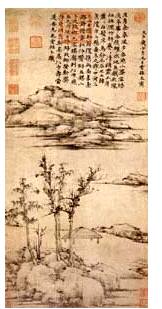
In 2001_/10/22 14:00-15:30, I deeply searched the 'Rong-xi Studio' by Ni-zan,(1304-1372/ 1301-1374) in National Palace Museum, Taipei. I cocluded that THIS is the best masterpiece among works attributed to Ni-tsan, and few of the others have become geniuine.
For several years, I had hoped the painting would have appeared in the museum gallery, but it not. In 1999, I heard that it might appear in coming "Yuan dynasty Arts Exhibition, but in 2001 summer, I heard it will not . I was not so patient to wait for uncertain next chance. I started to negotiate National Palace Museum through my friend , and I was fortunately gifted to search this painting. Because the painting is called the best masterpiece among Ni-tsan, I wanted to get a touchstone /standard to judge many paintings attributed to Ni-tsan. Moreover I had not so satisfied with some famous paintings attributed to Ni-tsan, so I thought that he might not be valued to his fame, if those paintings be genuine. When I visited the museum office, an elegant lady appeared. She is a curator of Paintings and Calligarphy department. Opening wide iron door, we got down to B1 Floor. On the left side of a banal path , we entered a room. Two men were. The painting was already spread on grey rag on long table. a large black container was on the floor. It was marked "painting" . Probably, they had carried the container from the warehouse. and took the painting . I felt the container has tens old masterpiece paintings, and became dazzeled.
I took a gauze mask with me from Japan for this. Not to say It defend the painting from cough and etc. The Lady offered a mask , but allowed me to use japanese one. Preparing a mask felt a good point for me. She let me appreciate it for 1 hours. I was willing to accept. At last, I could search it for 1 hours and 30min. I gave up for being extremely tired.
Thinking moneyseeking stance in the continent china museums, I prepared some money for the study. But, she emailed me that this special chance for scholars of chinese fine-arts be normal activity of National Palace Museum. I was seriously impressed with the honorable museum`s generousity and proud. Not to say, I offered rare/original/old academic sources of art-history as gift: it is sure mannner of gentleman.
hanging scroll format. ink on white paper,
Ni-zan drew many strokes as they be trying ones as hills and banks. When drawing trees and bushs ,he definitly drew the strokes skillfully.
I think these trying strokes are concious technique, not
unskill charcterstics.
Condition is generally good , thinking the date 1372.
Some cracks and some wored parts are found., but generally well preserved.
The paper is greish white, but originally white , because I observed the inner bright white material from wormholes.
Painter use dry ink, dilute-ink and dense-ink.
Two Descriptions and signatune by the painter himself have diffirent ink colours. The difference is very subtle, but it exists.
My friend suggest that the rightside 1st signature was executed on new paper, and the left wrote after x years, so the colour differed.
Additive Colophon on rough yellownish white silk is interporated to the upper part of the hanging scroll.
It was a part of the original/ early support silk. Someone wrote on silk directly. The calligraphy is not so fine, but old, probaly, in Ming dynasty.
Collectors seals are after 17th century. I feel strange.
Two 17th century Collector's seals are on the monting silk(lower left ) . It suggested that this mounting are executed in 17th century.
After the search. I watch the another painting attributed to him in 2F gallery of this museum.
I cannot appreciate it. I felt that it be just an old copy in Ming dynasty. The drawing quality of gloves is less, so
it cannnot attract me.
Indeed the mental state was too expired to appreciate any other artifacts in the galleries.the judge might seem too severe.
The painting likes a last section of "Fu-chun mountains " long handscroll
by Huang Guong-Wang(1269-1354)
Two famous painters were friends,
Exaggerated 'Hills beyond River' composition is not sign of
genuine Ni-zan.
Ching Dynasty Imperial Catalogue
Shi-ku-po-ku list this masterpice as 1st class,
which was saved in a Forbidden Palace.
in Beijing before 1744.